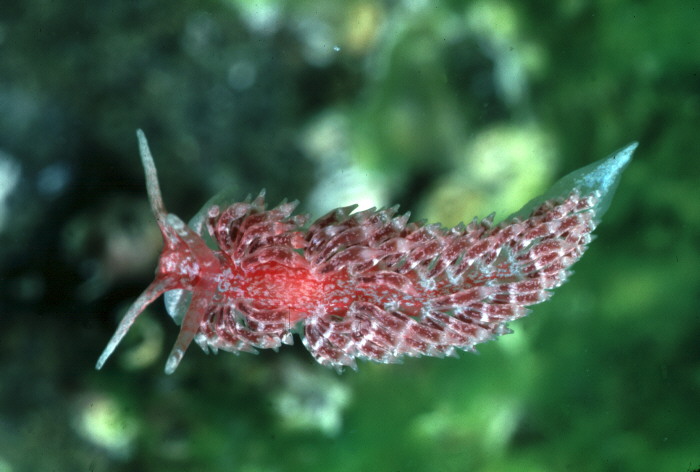 |
Anetarca armata
Photo courtesy of Jim Lance
Anetarca armata Gosliner, 1991
Anetarca armata is one of the more recently named species from the Pacific Coast of North America, and one with an interesting life style and name.
Lets begin with the critter itself and its name. Anetarca is a small aeolid species measuring up to 14 mm in length. The body is orange-red, and the ceratal cores brown. The body is densely covered with white to yellow-gold spots (see my Pacific Coast Nudibranchs, sp. # 204, pg 96, for another color photograph of this pretty species). The cerata of this species tend to curve toward the mid-line of the body. Internally the penis is armed with a chitinous spine, which is the reason Gosliner gave this species the 'trivial' name, armata.
While describing the species, Gosliner found that this little aeolid fit none of the existing genera and had to describe a new genus to assign this species. Because of its close anatomical similarity to members of the genus Cratena, but bearing the reproductive armature, Terry chose create a name depicting the differences/similarities by spelling Cratena backwards, and adding an "a" to give it the proper noun gender, hence - Anetarca.
Years ago while collecting in the Bahia de Los Angeles region, inside the Gulf of California, friend and colleague, Jim Lance first observed this species fascinating life style, which is depicted in the series of Jim photos below. Wes Farmer also described aspects of Anetarca's symbiotic relationship with another species of mollusk in his paper cited below.
To quote an old verse - its hard to say "which came first the chicken or the egg?" but its true here also, and I'm not sure which one Jim noticed first. One of the preferred prey species of A. armata is the a Hydractiniid hydroid which has been found to live on the gastropod shells of living Decipifus californicus and species of Nassarius both in the Gulf of California and in the Indo-Pacific (see Coral Reef Animals of the Indo-Pacific, sp. # 49, pg 27). A specimen of Decipifus covered with this hydroid is shown in the first photo below, followed by a shot of Anetarca feeding on the hydroid.
Like other species of Aeolidacean nudibranchs, Anetarca too insures its longevity as a species by laying eggs when food becomes limited and species seems to sense its days may be numbered. Also like other aeolids, it lays its eggs directly on its prey species, in this case the hydroid, which is being taxied around on the back of a snail. Photos 3 and 4 below depict this fascinating relationship, No. 3 showing the aeolid laying its convoluted egg ribbon (seen in detail in No. 4). Such a reproductive strategy would be perfect for a direct development species, where the larvae crawl directly from the egg onto the prey species, but it this case the nudibranch produces planktonic veliger larvae, which will disperse after hatching, and not settle until they find a fresh crop of the hydroid, most likely on the shell of another snail far from the parental host. Pretty cool, huh?
This species is known from Bahia de Los Angeles, within the Gulf of
California, to the outer coast of Baja at Punta Asuncion.
Citation
Gosliner, T.M. 1991a. Four new species and a new genus of opisthobranch gastropods from the Pacific coast of North America. Veliger 34(3):272-290. [Runcina macfarlandi, Baptodoris mimetica, Noumeaella rubrofasciata, Anetarca gen. nov., A. armata]
Wesley M. Farmer, 1990. A Strange Occurrence at Bahia de Los Angeles: Egg Laying on Nassarius and Decipifus.
The Festivus Vol. XXII(8): 95-95, 5 figures.1990
Click on an image or highlighted text to follow a link.
| Image | File | Size | Description | Location |
|---|---|---|---|---|
 | lan99_b4.jpg | 107K | Decipifus californicus covered with hydroids | Bahia de Los Angeles, Baja California |
 | lan99_b2.jpg | 93K | Anetarca armata on Decipifus californicus feeding on hydroids | Bahia de Los Angeles, Baja California |
 | lan99_b3.jpg | 112K | Anetarca armata laying egg streamers on Decipifus californicus | Bahia de Los Angeles, Baja California |
 | lan99_b1.jpg | 92K | Decipifus californicus crawling off with egg mass of Anetarca armata. | Bahia de Los Angeles, Baja California |
Taxonomic information courtesy of Dave Behrens

|
David W. Behrens
Author:
Pacific Coast Nudibranchs
Send Dave mail at seachalleng@earthlink.net
|
